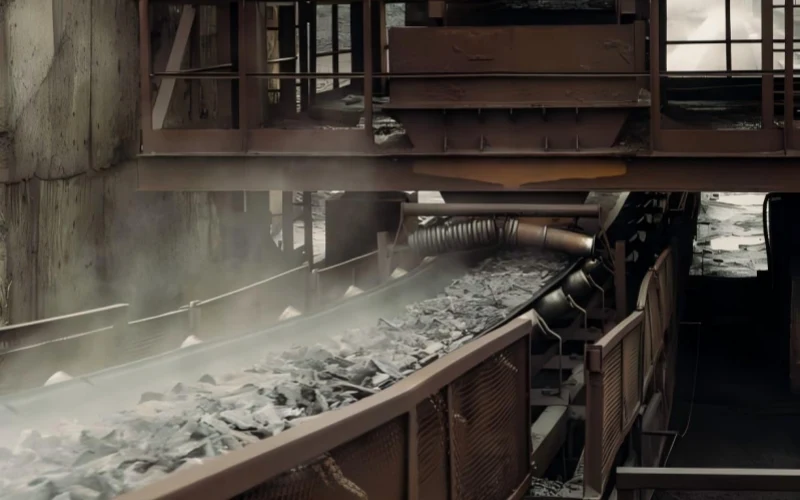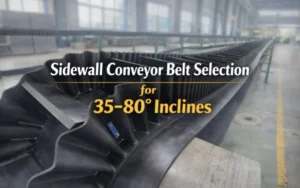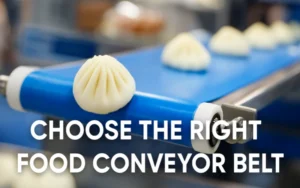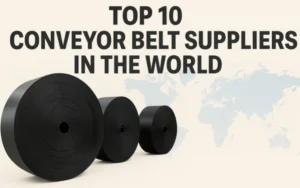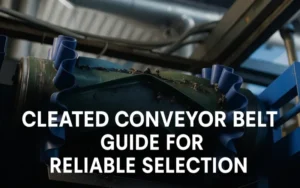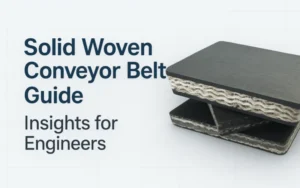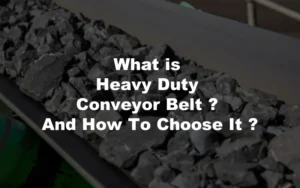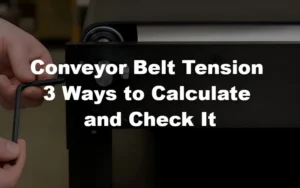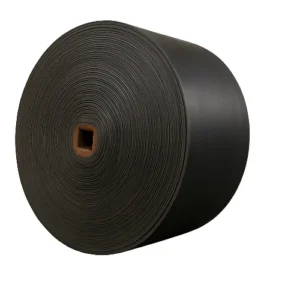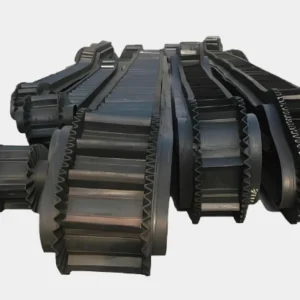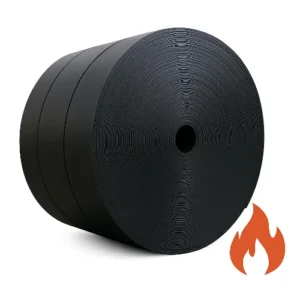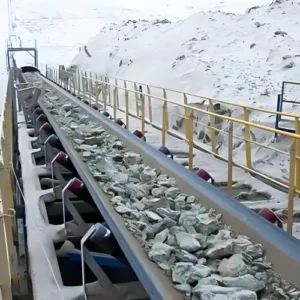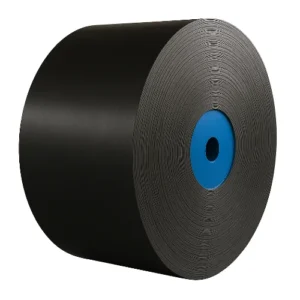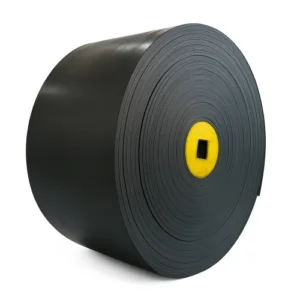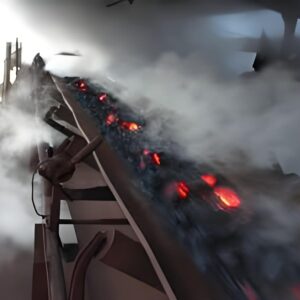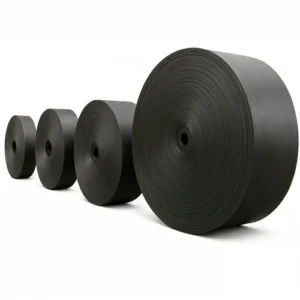Base life prediction formula:
Theoretical Belt Life (hours) = Cover Thickness (mm) ÷ Surface Loss Rate (mm per 100h) × 100
DIN wear values converted to thickness loss:
Wear Depth (mm) = Abrasion Value (mm³) ÷ Contact Area (mm²)
Real remaining life modeling:
Remaining Life (h) = (Measured Remaining Thickness) ÷ Measured Wear Rate × 100
Advanced environmental discount factor:
Adjusted Life = Base Life × e⁻(0.02T + 0.005RH + 0.1×UV)ᵗ
1.Conveyor Belt Life Calculation Matters
In heavy industry, failures rarely arrive with warning signs. They build quietly—grain by grain, impact by impact—until the entire system slows or stops. This is why conveyor belt life calculation isn’t a theoretical concept; it’s an operational necessity.
Abrasion is the primary factor behind the early decline in rubber conveyor belt lifespan. Abrasion. Not sudden, but consistent, progressive wear that strips value and efficiency from your system over time. Ignoring this means guessing instead of managing.
Predictive models based on abrasion test for rubber belt data allow engineers to evaluate belt performance under realistic conditions. By analyzing abrasion value of rubber and wear data under specific loads and speeds, teams can perform precise conveyor belt wear calculation. This isn’t just for the lab—it’s the basis for smarter material selection and service scheduling.
Choosing the right abrasion resistant conveyor belt becomes easier with data. It’s not about overengineering; it’s about aligning belt strength with your process reality. At the same time, belt cover thickness loss and surface degradation need ongoing tracking. A simple conveyor belt inspection checklist, if applied consistently, can reveal early-stage damage patterns and prevent escalation.
In essence, conveyor belt life calculation provides the structure needed for high-reliability systems. It’s about shifting from reactive repair to proactive planning. For industries where every hour counts, that shift defines long-term competitiveness.

2.Conveyor Belt Life Calculation Variables
In any serious conveyor belt life calculation, separating material science from operational stress is essential. The most reliable predictor of how long a rubber belt can last isn’t guesswork—it’s the rubber’s abrasion value. But this value, despite its importance, is often misunderstood in practice. Many interpret it as a fluctuating indicator of wear behavior, when in fact, it is a stable, laboratory-defined constant that reflects the rubber’s inherent resistance to volume loss under abrasive conditions.
2.1 Abrasion Value as a Fixed Benchmark
Derived from standardized procedures such as ISO 4649 or DIN 53516, the abrasion value of rubber is expressed in mm³, representing the volume of material lost during controlled friction testing. The core formula is:
Abrasion (mm³) = Δm / ρ
where Δm is the sample’s weight loss (mg) and ρ is the material density (mg/mm³). This yields a fixed number that characterizes the wear resistance of a particular rubber formulation. For instance, a belt sample with a weight loss of 120 mg and a density of 1.14 mg/mm³ will show an abrasion value of approximately 105.26 mm³.
This result does not change with time or operational use—unless the rubber is chemically or physically altered, for example through oxidation, UV exposure, or high-temperature degradation. In standard environments, the abrasion value is a reliable baseline.
2.2 Operational Variables That Influence Wear Rate
While the abrasion value remains unchanged, what does vary is how quickly that material is removed in real applications. That difference lies in operational variables—external forces that accelerate the material loss toward the known abrasion threshold.
These include:
- Belt speed: Higher speeds increase surface contact frequency and thermal buildup.
- Loading conditions: Irregular or high-impact loading causes localized belt cover thickness loss, especially at transfer points.
- Material properties: Sharp, dense, or angular materials generate more aggressive abrasion.
- Tension accuracy: Poor tension control leads to slippage or over-stretch, affecting the belt surface and edges.
- Cleaning systems: Misadjusted scrapers or improper blade materials may scratch the rubber, acting as unintended abrasive agents.
While these factors do not reduce the abrasion resistance of the belt, they accelerate the rate at which the belt’s fixed abrasion value is consumed—essentially shortening the time before functional failure.
2.3 Material Construction and Long-Term Integrity
Abrasion resistance isn’t only about surface compound. The internal structure of the abrasion resistant conveyor belt plays a significant role in how it survives under duress:
- Cover compound grade: DIN X or ISO H compounds offer lower abrasion values than general-purpose rubber.
- Rubber cover thickness: Thicker covers extend the time before reinforcement layers are exposed.
- Reinforcement fabric: EP (polyester/nylon) offers high tensile strength, while NN allows more flexibility.
- Adhesion strength: Weak bonding between layers causes internal delamination, which is not directly detected by abrasion tests.
- Thermal and chemical resistance: Aging and oxidation can lead to hardening and cracking, undermining abrasion protection.
Understanding the total belt structure allows users to relate the abrasion value of rubber to real-world durability in a more holistic way.

2.4 Abrasion Value and the Life Prediction Equation
A common industry formula for estimating belt life is:
Theoretical Belt Life (hours) = Cover Thickness (mm) ÷ Surface Removal (mm/100h) × 100
However, it’s critical to note: abrasion value (in mm³) cannot be directly used in this formula. The life model requires linear wear data—specifically, how much surface layer (in mm) is lost over a known time period. Abrasion value must first be converted by dividing it over the worn area to estimate thickness loss. This requires on-site measurements or calibrated field tests.
In short, abrasion value feeds into the model—but cannot replace real-time surface wear measurements.
2.5 Role of Inspection in Validating Models
Since the abrasion value is fixed, there’s no need to retest it unless the rubber’s condition has degraded chemically. Instead, ongoing field inspection using a structured conveyor belt inspection checklist is critical. Tracking actual wear against the theoretical model enables early correction, detects abnormal wear patterns, and confirms whether operational practices are in line with the expected rubber conveyor belt lifespan.
Integrating lab-tested material data with in-field monitoring brings conveyor belt life calculation out of the lab and into daily operations—supporting informed decisions, reducing unexpected failures, and enhancing system efficiency over time.

3.Conveyor Belt Life Calculation and Global Abrasion Standards
When planning for long-term conveyor belt durability, engineers cannot rely on one uniform measurement across international supply chains. Though the abrasion value of rubber remains the critical factor for conveyor belt life calculation, how this value is defined and classified depends heavily on regional standards. These standards not only shape supplier communication but also affect belt selection, pricing, and performance guarantees.
Understanding and comparing these systems ensures that procurement decisions are data-driven and application-specific—especially when sourcing belts from multiple countries or when exporting to international markets.
3.1 Why Standards Matter in Abrasion Calculations
The abrasion value itself is a fixed property, but how it is tested, interpreted, and labeled varies across countries. While DIN and ISO have become widely referenced globally, countries like China, the US, Japan, and Russia continue to apply their own frameworks with varying testing conditions, grade labels, and threshold tolerances.
Therefore, integrating abrasion standards into conveyor belt life calculation means doing more than plugging in numbers—it means translating standards across systems, and ensuring you are comparing like for like.
🇨🇳3.1.1 China – GB/MT Standards for Cover Rubber
China’s GB/MT standards classify cover rubber into multiple grades based on abrasion resistance, tensile strength, and elongation. These standards are widely adopted in domestic heavy industries such as coal mining and construction.
| Tape Type | Covering type | Tensile Strength | Elongation | Wear | hardness | Implementation Standards |
| Flame retardant core belt | Thick cover rubber type | ≥10.0 | ≥250 | ≤200 | 70tu5 | MT914-2002 |
| Flame retardant | ≥10.0 | ≥350 | ≤200 | 70tu5 | ||
| Ordinary layered belt | LightweightL | ≥10.0 | ≥300 | ≤250 | 60tu5 | GB7984-87 |
| Normal M | ≥14.0 | ≥350 | ≤200 | 60tu5 | ||
| Heavy H | ≥18.0 | ≥400 | ≤150 | 60tu5 | ||
| Ordinary layered belt | Ordinary Type L | ≥15.0 | ≥350 | ≤200 | 60tu5 | GB7984-2001 |
| Strong wear D | ≥18.0 | ≥400 | ≤100 | 60tu5 | ||
| Strong scratch H | ≥24.0 | ≥450 | ≤120 | 60tu5 | ||
| Flame retardant layered belt | Flame retardant | ≥14.0 | ≥400 | ≤250 | 60tu5 | GB10822-2003 |
| Flame retardant D | ≥18.0 | ≥450 | ≤200 | |||
| MT147 Steel Barrier Strip | Flame retardant | ≥10.0 | ≥250 | ≤250 | 70tu5 | MT147-87 |
| MT668 steel resistance belt | ≥15.0 | ≥350 | ≤200 | 70tu5 | MT668-1997 | |
| Ordinary steel strip | Heavy H | ≥17.65 | ≥450 | ≤150 | 60tu5 | GB9770-88 |
| Normal M | ≥13.73 | ≥400 | ≤200 | 60tu5 | ||
| Ordinary steel strip | Strong wear D | ≥18.0 | ≥400 | ≤90 | 60tu5 | GB9770-2001 |
| Strong scratch H | ≥25.0 | ≥450 | ≤120 | 60tu5 | ||
| Ordinary Type L | ≥20.0 | ≥400 | ≤150 | 60tu5 | ||
| Special Type P | ≥14.0 | ≥350 | ≤200 | 60tu5 | ||
| Heat-resistant belt | Type T2 | ≥10.0 | ≥350 | ≤200 | 60tu5 | HG2297-92 |
| Type T3 | ≥12.0 | ≥350 | ≤200 | 70tu5 |
🇩🇪3.1.2 Germany – DIN 22102 Standard Grades
Germany’s DIN 22102 classification is one of the most commonly referenced standards worldwide. It defines grades like DIN Y, X, and W, each with increasing abrasion resistance.
| Tape Type | Covering type | Tensile Strength | Elongation | Wear | hardness | Implementation Standards |
| Common | W | ≥18.0 | ≥400 | ≤90 | 60tu5 | DIN22131 or 22102 |
| X | ≥25.0 | ≥450 | ≤120 | 60tu5 | ||
| Y | ≥20.0 | ≥400 | ≤150 | 60tu5 | ||
| Z | ≥15.0 | ≥350 | ≤250 | 60tu5 | ||
| Flame retardant belt | K | ≥20.0 | ≥400 | ≤200 | 60tu5 | DIN22103 |
| Flame retardant, static electricity self-extinguishing | V | ≥15.0 | ≥350 | ≤150 | 60tu5 |
🇦🇺3.1.3 Australia – AS 1332/AS 1333 Rubber Cover Grades
Australian standards focus on belt applications under demanding environments such as open-pit mining and bulk handling. These values are often harmonized with ISO test methods.
| Tape Type | Covering type | Tensile Strength | Elongation | Wear | hardness | Implementation Standards |
| Wear-resistant belt | A | ≥17.0 | ≥400 | ≤70 | 60tu5 | AS1333-94 |
| Conductive static electricity | E | ≥14.0 | ≥300 | … | 60tu5 | |
| Flame retardant belt | F | ≥14.0 | ≥300 | … | 65 soil 5 | |
| Ordinary belt | M | ≥24.0 | ≥450 | ≤125 | 60tu5 | |
| TZ | ≥23.0 | ≥550 | ≤125 | 64tu5 | ||
| N | ≥17.0 | ≥400 | ≤200 | 60tu5 | ||
| Flame retardant and static conductive | S | ≥14.0 | ≥300 | ≤250 | 65 soil 5 | |
| PVC material | S | ≥12.0 | ≥300 | ≤250 | 70tu5 | AS1332:1991 |
🌐3.1.4 ISO – International Standard for Abrasion (ISO 4649)
ISO 4649 provides globally accepted procedures for measuring abrasion value of rubber. It does not assign letter grades but sets up test parameters that national systems may reference or adopt.
| Tape Type | Covering type | Tensile Strength | Elongation | Wear | hardness | Implementation Standards |
| Strong cutting and tearing | H | ≥24.0 | ≥450 | ≤120 | 60tu5 | ISO10247:1990 |
| Severe wear | D | ≥18.0 | ≥400 | ≤100 | 60tu5 | |
| Moderate wear | L | ≥15.0 | ≥350 | ≤200 | 65 soil 5 |
🇷🇺3.1.5 Russia/CIS – ГОСТ (GOST) Soviet-legacy Standards
Russia and CIS countries still use ГОСТ (GOST) norms, which reflect older European influences but have local-specific grading systems.
| Tape Type | Covering type | Tensile Strength | Elongation | Wear | hardness | Implementation Standards |
| Ordinary belt | A | ≥24.5 | ≥450 | ≤160 | 40~60 | ГОСТ 20-85 |
| B | ≥19.6 | ≥400 | ≤160 | 50~70 | ||
| N | ≥15.0 | ≥400 | ≤100 | 55~75 | ||
| C | ≥10.0 | ≥150 | ≤200 | 50~70 | ||
| M | ≥14.7 | ≥350 | ≤150 | 45~65 | ||
| Heat-resistant belt | T1≤100℃ | ≥11.0 | ≥400 | ≤160 | 55~75 | |
| T2≤150℃ | ≥10.0 | ≥300 | ≤200 | 60~75 | ||
| T3≤200℃ | ≥11.0 | ≥400 | ≤200 | 55~75 | ||
| 2T1≤80℃ | ≥14.7 | ≥350 | ≤200 | 55~75 | ||
| 2T2≤100℃ | ≥14.7 | ≥300 | ≤200 | … | ||
| Food belt | JI | ≥9.8 | ≥300 | … | … |
🇯🇵3.1.6 Japan – JIS Cover Rubber Classification
Japan’s JIS K 6322 standard divides cover rubber by performance in abrasion, elongation, and tensile resistance, usually expressed with letter grades like A, B, C.
| Tape Type | Covering type | Tensile Strength | Elongation | Wear | hardness | Implementation Standards |
| Ordinary belt | P | ≥8.0 | ≥300 | ≤400 | … | JIS K 6322:1999 |
| G | ≥14.0 | ≥400 | ≤250 | … | ||
| S | ≥18.0 | ≥450 | ≤200 | … | ||
| A | ≥14.0 | ≥400 | ≤150 | … | ||
| Strong cutting and tearing | H | ≥24.0 | ≥450 | ≤120 | 60tu5 | ISO10247:1990 |
| Severe wear | D | ≥18.0 | ≥400 | ≤100 | 60tu5 | |
| Moderate wear | L | ≥15.0 | ≥350 | ≤200 | 65 soil 5 |
🇬🇧3.1.7 United Kingdom – BS 490 and Related Standards
British Standard BS 490 is used in various heavy industries and often overlaps with European DIN terminology but maintains UK-specific labeling for legacy applications.
| Tape Type | Covering type | Tensile Strength | Elongation | Wear | hardness | Implementation Standards |
| Ordinary layered belt | M24 | ≥24.0 | ≥450 | BS490:P1:1990 | ||
| N17 synthetic rubber | ≥17.0 | ≥400 | ||||
| N17 | ≥17.0 | ≥400 | ||||
| B | ≥15.0 | ≥350 | ≤150 | 60tu5 | ||
| Flame retardant core belt | ≥15.0 | ≥400 | BS490:P3:1991 |
🇺🇸3.1.8 United States – RMA (now ARPM) Belt Grades
In the United States, the Rubber Manufacturers Association (RMA)—now the ARPM—specifies belt cover grades primarily as Grade I and Grade II, based on abrasion and impact resistance.
| Tape Type | Covering type | Tensile Strength | Elongation | Wear | hardness | Implementation Standards |
| RMA1 | ≥17.0 | ≥450 | ≤150 | 60tu5 | ||
| RMA2 | ≥14.0 | ≥400 | ≤175 | 65 soil 5 |
3.2 Application Advice for Engineers and Buyers
3.2.1 Align testing protocols: Always confirm if values are measured under ISO, DIN, or local protocols—do not assume cross-standard comparability without verification.
3.2.2 Map equivalent grades: Use standard comparison tables to match DIN X to GB/MT D, RMA Grade I, or JIS A80, for example.
3.2.3 Use abrasion values in modeling: Once standard parameters are translated into known abrasion value of rubber, these numbers can be used in linear life estimation models.
3.2.4 Inspect incoming belts: Use a conveyor belt inspection checklist to verify physical conformity and manufacturer claims before installation.
3.2.5 Retest if stored or aged: Long storage or UV exposure can degrade rubber, making the original abrasion rating unreliable—retest if in doubt.

4. Abrasion Value Is Just the Beginning of Conveyor Belt Life Calculation
Let’s be honest—most people don’t appreciate the complexity of a conveyor belt until the line stops. Only then does the conversation shift from “How much did it cost?” to “Why didn’t we know it would fail?” This is where conveyor belt life calculation comes in—not as a one-time math exercise, but as an ongoing system of observation, modeling, and correction.
And while many people lean heavily on the abrasion value of rubber, treating it as a kind of gospel—it’s only half the truth.
4.1 What Abrasion Value Actually Tells You
Tested under ISO 4649 or DIN 53516, the abrasion value reflects how much rubber volume (in mm³) is removed from a sample under standard conditions. A result like 105 mm³ means the compound lost that much material during the test. It’s useful because it’s consistent and reproducible. You can compare two belts, two suppliers, or two production batches using that number.
But it’s not a crystal ball.
A belt with an abrasion value of 85 mm³ might last twice as long as one with 130 mm³—if everything else is equal. And in the real world, “everything else” is rarely equal. Conveyor systems operate in humidity, dust, impact zones, misaligned rollers, inconsistent loading, and often, incomplete maintenance.
So yes, abrasion value of rubber is essential—but no, it’s not enough.
4.2 From Volume to Time: The Real Challenge
Most plant engineers aren’t just asking, “What’s the abrasion value?” They’re asking, “How long will this belt last under my load, speed, and conditions?”
To get there, we have to convert lab numbers into field time. That starts with estimating how much rubber is being lost per hour.
Take this simple model:
- Cover thickness: 6 mm
- Estimated thickness loss: 0.06 mm per 100 operating hours
6 ÷ 0.06 × 100 = 10,000 operating hours
Sounds solid—but where did that 0.06 mm come from? If it’s based on guesswork, the model collapses. If it’s from previous inspections or real wear data, it becomes actionable.
That’s the key: conveyor belt life calculation only works if it’s fed with more than catalog specs. It needs on-site measurement, logging, and follow-up.

4.3 Abrasion Value in Procurement: Context Is Everything
One common mistake is to buy belts solely based on abrasion rating. Procurement gets a quote for DIN Y with 150 mm³ abrasion, then finds another supplier offering DIN X at 90 mm³. The logic says: lower number, longer life, better deal.
But what if that “better” compound can’t handle your load’s temperature? Or delaminates under tension? Or costs 30% more with no gain under your application?
That’s why context matters. A lower abrasion value is helpful—but only when other variables align. Good conveyor belt durability is a function of system match, not spec sheet perfection.
4.4 Observation Is the Other Half of Prediction
Even the best compound will underperform if ignored. Many belts fail not because they wore out too fast, but because no one was watching.
That’s where routine tracking—simple depth checks, visual inspections, and documentation—proves its worth. When wear doesn’t match prediction, you get a story:
- Is the material sharper than expected?
- Did the scraper come loose?
- Was the belt tension readjusted last shutdown?
Over time, these observations feed back into your model, refining the rate of conveyor belt wear calculation and helping you set more accurate replacement intervals.
4.5 Practical Example: Matching Theory to Field
Let’s say your supplier gives you a belt with a rated abrasion value of 95 mm³. Your system has a loading zone width of 300 mm and typical throughput of 200 tons per hour. During quarterly inspection, you record 0.12 mm cover loss per 100 hours.
Plug that into your life model:
6 mm ÷ 0.12 mm/100h × 100 = 5,000 hours
But your last belt lasted only 3,800 hours. Why?
Now the investigation starts: belt misalignment, impact from material drop height, or scraper damage—all candidates. That’s how abrasion value becomes more than a lab number—it becomes a conversation starter, a baseline to test reality against.

4.6 Models Don’t Fail—Assumptions Do
The biggest risk in rubber conveyor belt lifespan prediction isn’t bad data. It’s trusting incomplete data. Abrasion value helps, but only if paired with system awareness, site observation, and maintenance discipline.
So don’t throw out your formulas. Just make sure they’re tied to something real.
5.How Conveyor System Design Impacts Belt Wear
When trying to extend the rubber conveyor belt lifespan, many people focus on the belt’s material properties—abrasion value, cover grade, carcass type. But often, the biggest wear accelerators aren’t in the belt at all—they’re in the structure around it. System design is one of the most overlooked variables in conveyor belt life calculation, and it often makes the difference between a belt that runs 8,000 hours and one that barely lasts 3,000.
5.1 Belt Speed: The Quiet Multiplier of Friction
The faster a conveyor belt moves, the more contact cycles it completes per hour—resulting in more frequent friction, accelerated cover wear, and increased heat buildup. But Conveyor Belt life calculation isn’t just about friction cycles. Higher belt speeds also amplify material impact force, especially at high-drop zones or poorly aligned loading points, which can significantly shorten operational lifespan.
In some systems, operators increase speed to meet production targets without redesigning the transfer point. As a result, material slams the belt harder, spreads faster, and grinds deeper into the surface.
What to watch for:
- Edge fraying from lateral belt flutter at high speed
- Surface cracking near loading zones
How to fix it:
- Set speeds based on material type—abrasive materials do better at 1.2–1.8 m/s
- Use variable frequency drives to adjust speed dynamically based on load

5.2 Roller Spacing and Roller Failure: Invisible Damage Creators
Rollers are designed to support, but when spacing is inconsistent or rollers seize, they become wear agents. Too much spacing between rollers allows the belt to sag, creating a deeper trough. This leads to uneven loading, material spillover, and flex-fatigue in the centerline. Seized rollers, meanwhile, act like grinders—rubbing a single spot of the belt until the rubber overheats, hardens, and cracks.Therefore, it is not only the objects transported on the conveyor belt surface that will affect the conveyor belt life calculation.
Common symptoms:
- Random hot spots along the return path
- Localized belt hardening or glazing
Solutions:
- Keep carrier roller spacing within 1–1.5 times belt width (per ISO 5048)
- Use impact-rated rollers in loading zones
- Install rotation sensors to detect seized rollers early

5.3 Drop Height and Impact Design: Where Energy Becomes Wear
Many belts die early due to uncontrolled impact energy. A one-meter increase in drop height doesn’t sound like much, but it can increase impact force by over 50%. When heavy or angular material hits the belt at high speed, it tears into the cover—regardless of how low the abrasion value of rubber is.
In some cases, we’ve seen new belts begin to crack within just 2–3 weeks—usually because large stone chunks from a crusher were dropped repeatedly onto the same spot. Situations like this highlight why Conveyor Belt life calculation must account not just for abrasion, but also for concentrated impact stress at loading points.
Design improvements:
- Add rubber liners, ceramic liners, or step-down chutes in impact zones
- Use adjustable skirting to direct material more gently onto the belt
- Match chute exit velocity to belt speed to reduce friction

5.4 Scraper Design and Setup: Necessary But Risky
Scrapers play a key role in keeping belts clean, but they’re also a frequent contributor to premature surface wear. According to Conveyor Belt life calculation best practices, improperly installed scrapers—especially those set at the wrong angle or tension—can cause continuous surface abrasion. While most scraper blades use PVC or rubber contact edges rather than metal, even slight misalignment can lead to fine groove patterns that evolve into cracks over time. On the flip side, soft or overly worn scrapers may allow fine material to accumulate on the belt surface, forming a compact abrasive layer that accelerates cover degradation under load.
What to monitor:
- Groove marks or cuts along belt center-line
- Incomplete cleaning near edges or at tail pulleys
Better setup:
- Use polyurethane blades with medium hardness (Shore A85–90)
- Combine primary (drive-side) and secondary (return-side) scrapers
- Adjust scraper angle regularly—ideally every 500–1,000 hours

5.5 Tension: A Constant Variable
Improper belt tension impacts nearly every aspect of wear. Under-tension leads to slippage, causing excessive heat buildup at the drive pulley and accelerating cover degradation. Over-tension, meanwhile, puts excessive strain on the splice and carcass, raising the risk of internal fatigue and delamination. Effective Conveyor Belt life calculation must consider both extremes, as tension-related damage often compounds silently until failure occurs.
Many systems are tensioned once during installation and rarely checked again—until the belt starts slipping or tearing.
Typical problems:
- V-shaped black marks near the drive pulley from slippage burns
- Fractured splices due to over-pull during thermal expansion
Improvements:
- Use hydraulic or screw-adjustable tension systems
- Monitor tension via load cells or belt sag measurements
- Check belt tension at every planned shutdown

5.6 Other Structural Weak Points
Component | Risk | Optimization Tip |
Pulley diameter | Small pulleys increase bending stress on the belt | Increase drive pulley diameter to reduce flex damage |
Chute width | Narrow inlets cause material to hit edges | Use wider chutes and align with belt center-line |
Environmental seal | Water, dust, and debris accelerate surface wear | Install belt covers and side sealing skirts |
6.Conveyor Belt Materials & Structure: Deep Analysis and Smart Design for Wear Resistance
When evaluating conveyor belt life calculation, it’s tempting to focus on abrasion ratings or cover thickness. But belt performance starts with the material and engineering of the belt itself. Think of cover compound and internal structure as the belt’s DNA—once it’s built, design quirks can’t hide. Here’s how each layer and splice decision influences rubber conveyor belt lifespan, and what design choices prevent early failure.
6.1 Cover Compound Grades
The wearing surface—cover compound—is the belt’s first defense. It’s determined by filler content (like carbon black or silica), rubber crosslink density, and stiffness. Standards such as DIN 22102 measure how much material is lost in abrasion testing:
Grade | Abrasion Limit (mm³) |
W | ≤ 200 |
Y | ≤ 120 |
X | ≤ 90 |
- DIN X compounds resist cutting from sharp materials. However, high stiffness makes them more prone to cracking under impact.
- DIN Y offers better elasticity but can be accessorized with ceramic or tile inserts to resist adhesive damp materials.
- DIN W, the standard compound, suits light-duty bulk materials without high abrasion or impact.
If your bulk load involves iron ore, quartz, or granite, opt for DIN X-grade belts with at least 6 mm of top cover to withstand heavy abrasion. For lighter yet dusty materials like coal, DIN Y combined with anti-stick treatments helps minimize carryback. In highly abrasive and sticky environments, integrating ceramic or metal insert strips into the cover layer can further extend service life. These choices should always be part of a proper Conveyor Belt life calculation, as material type and cover design directly influence wear rate and long-term performance.
6.2 Carcass Fabric and Layering
The belt’s internal fabrics support load and maintain structural integrity. Your choices affect strength, flexibility, and resistance to internal damage.
Fabric Type | Strength | Bending Fatigue | Impact Resistance |
EP (polyester + nylon) | High & stable | Excellent | Good |
NN (nylon-only) | Medium | Good | Excellent |
Steel-cord (ST) | Very High | Poor with flex | Poor at lateral loads |
Layer count matters too. Too many plies increase stiffness, increasing shear stress between layers during bending. Too few plies compromise tensile strength, forcing harder cover compounds. You’ll find these useful pairings in practice:
- Long-distance and heavy-duty belts(like ship-loaders) favor steel-cord carcasses and require large pulley diameters (over 800 mm) to avoid cord fatigue.
- High-impact settingslike ore feed belts do better with 3–4 layers of EP carcass and a thick cover, balancing cut resistance with bounce.
Also, consider hybrid carcasses that combine EP layers with steel cords for certain reverse-bend applications.
6.3 Adhesion Strength Between Layers
Bending stress will separate layers unless they’re properly bonded. Without strong adhesion, micro-cracks form and allow moisture or dust to enter, breaking down the bond.
To ensure bond strength:
- Adhesion should exceed 8 N/mm(EP) or 12 N/mm (steel-cord), per ISO 252.
- After aging at 70 °C and high humidity for 7 days, adhesion must remain above 80%of original strength.
Solutions include RFL treatment on fabric and multi-layer calendared rubber with buffer layers to absorb shear.
When inspecting used belts, look for signs of ply separation along rollers or under cracks where moisture has penetrated. Ultrasonic testing often reveals delamination before it shows on the surface.

6.4 Splice Type and Quality
Splices are where many belts fail—especially in high-wear or flex zones.
Splice Type | Strength Retention | Notes |
Hot vulcanized | 90–95% | Strongest, needs press & heat |
Cold bonded | 70–85% | Easier, but weaker |
Mechanical joint | 50–60% | Quick but risk gouging |
Hot-vulcanized splices outperform the rest and provide a smooth joint surface. Make sure the overlap is at least 1.5× belt width and built in stepped layers to reduce stress. Curing should occur under ~145 °C and 1.5–2.0 MPa pressure for a time matched to the compound type (often 45–60 minutes).
Field failures often begin at splice shoulders—check for rough edges or material gaps.
6.5 Aging Resistance of the Cover Compound
The cover doesn’t stay young forever. Aging factors like heat, ozone, UV light, and chemicals degrade rubber.
- Friction heating from belt slippage over pulleys (exceeding 100 °C) actually breaks molecular chains.
- Ozone and sunlight create cracking patterns you often see at idler points or belt edges.
- Acidic or alkaline materials in some ores—especially phosphate—can erode the surface. If pH is under 4, look for acid-resistant compounds.
Resistance tactics include antioxidants (RD, 4020) and ozone suppressants such as microcrystalline wax. Non-contact sides can be made with chlorine-resistant rubber to extend overall belt life.
Look for cracking patterns on returning belt surfaces—often a sign of ozone damage or aging.

6.6 Putting It Together: Structure Dictates Life
Choose materials based on the most damaging forces you expect:
- If abrasion rules—go with DIN X + thick EP carcass.
- If impact is more critical—choose a more elastic compound (DIN Y or a blend) with NN or hybrid carcass.
- Environmental challenges? Add anti-aging layers or protective membranes.
Even premium solutions—like ceramic-enriched covers—can be more economical in the long run if they outlast basic belts 3× to 5× more and reduce unscheduled downtimes.
6.7 Verification: Lab Testing and Field Validation
Before buying or installing a belt:
- Run a DIN 53516 abrasion teston the sample compound.
- Verify heat resistance with friction tests at expected speed and load conditions.
- Roll out the first belt and inspect every 500 hours, using ultrasonic or peel checks to catch delamination or aging.
Inspection should ideally reveal bonding wear or early splits—addressing these quickly can prevent belt failure.
6.8 Case Examples—Numbers That Speak
- Steel Mill Upgrade: A switch from a 3-layer NN, DIN W belt (4,000 h lifespan) to 4-layer EP DIN X with larger pulleys boosted lifespan to 9,500 h—more than double.
- Coal Power Conveyor: Original two-layer NN belt lasted only 1,800 h. After upgrading to 4-layer EP DIN Y with ceramic inserts, belts now run beyond 6,000 h without issue.
- Open-Air Phosphate Conveyor: Belts were cracking from sun exposure. Switching to compound with anti-aging top layer delayed wear—one belt operated two rainy seasons with minimal cover damage.
7.Operating Conditions & Material Characteristics
In the world of conveyor belt life calculation, understanding belt materials and structural properties isn’t enough. The real drivers of wear and failure are often hidden in the materials you handle and the conditions you run under. Let’s break down the major factors—from rock sharpness to startup frequency—along with mechanisms and smart countermeasures.
7.1 Aggregate Particle Size & Sharpness
Wear mechanism
Sharp, angular particles—such as granite or quartz—primarily cause abrasion through micro-cutting and fatigue peeling, which, as Conveyor Belt life calculation shows, leads to groove-like wear patterns and faster surface degradation. In contrast, rounded pebbles or cobbles produce roughly 30–50% less wear, since they roll or compress rather than cut into the belt cover.
7.1.1 Quantified impact
According to Rabinowicz wear formula:
Wear volume ∝ F × tan(θ) ÷ H
- F: applied load
- θ: particle edge angle
- H: cover hardness
Sharp angular particles with steep edge angles (high θ) greatly increase wear at the same load and hardness.
7.1.2 Countermeasures
- Compound upgrade: Use rubber modified with ultra-high molecular weight polyethylene (UHMWPE) to resist cutting.
- System design: Add impact-resistant plates or ceramic liners at loading points to distribute stress and reduce gouging.
7.2 Wet or Dry Powders and Sticky Loads
7.2.1 Wear mechanism
Wet or sticky materials—like clay or slurries—can form boundary lubrication layers that soften the rubber surface and, over time, accelerate chemical and mechanical degradation. For accurate Conveyor Belt life calculation, it’s important to account for these subtle but damaging effects. Dry powders such as cement or coal dust, by contrast, tend to cause three-body abrasion, with fine particles trapped between the belt and rollers constantly grinding the surface.
7.2.2 Critical factors
- When material moisture exceeds ~8%, wear rate can increase by 2–3×.
- Friction coefficient drops from ~0.4 to ~0.2 in wet conditions but with added abrasive drag and adhesion effects.
7.2.3 Innovative solutions
- Surface texturing: Laser-engraved micro-grooves (0.2–0.5 mm deep) on the belt surface help drain water and debris.
- Coating: Fluorine-treated covers offer low surface energy and resist acidic or basic environments.
7.3 High-Temperature Material (>160 °C)
7.3.1 Thermal damage threshold
Common conveyor compounds have these thermal limits:
Compound | Continuous Temp | Instant Limit |
SBR | 80 °C | 120 °C |
EPDM | 150 °C | 180 °C |
Silicone | 200 °C | 250 °C |
Once temperatures exceed ~160 °C, sulfur crosslinks break, rubber hardens (50% increase in hardness), and loses toughness. If the cover is over 10 mm thick, internal gasses can lead to peeling or delamination.
7.3.2 Special strategies
- Composite wear surface: Ceramic tile inserts handle up to 400 °C and absorb impact.
- Cooling: Integrate air-cooled chutes or water-cooled drums at loading points to mitigate heat.

7.4 Foreign Object Impact (e.g., Metal Fragments)
7.4.1 Damage types
- Impact gouging: Nails or sharp steel shards embed into the belt and, under load, act as crack initiation points.
- Peeling abrasion: Repeated scraping by metal bits leads to peeling loss of rubber surfaces.
7.4.2 Protection strategies
- Active screening: Use electromagnetic separators (≥1200 Gauss) and metal detectors to remove ferrous debris.
- Passive protection: Install steel-cord or aramid (Kevlar) belts, which improve transverse tear strength by up to 300%.

7.5 High Start-Stop Frequency
7.5.1 Dynamic wear insights
Each start-up is a friction event—static to dynamic slip generates a flash temperature rise. Local belt temperatures can hit 200 °C in just a few seconds, weakening the rubber and the splice. Frequent starts also cause tension spikes, accelerating fatigue per Miner’s cumulative damage theory.
7.5.2 System improvements
- Soft-start drives: Controlled start time (30–60 seconds) reduces thermal shock and tension spikes.
- Smart tensioning: Hydraulic or servo-tensioned systems keep tension within ±5% even during load changes.
7.6 Material–Condition Decision Matrix
To align compound and structure choices with operating conditions, here’s a practical decision-making table:
Condition | Preferred Solution | Avoid |
High sharpness & large particles | DIN X cover + 4-layer EP500 carcass + ceramic liner | Thin cover <5 mm; NN carcass |
High temp + sticky, wet materials | EPDM compound + ST steel-cord + micro-grooved cover | Standard SBR; mechanical joint |
Frequent starts/stops | Aramid belt + hydraulic tensioner + soft-start drive | Fixed tension; direct-on drives |
7.7 Advanced Monitoring & Predictive Maintenance
Modern belt wear management includes embedded monitoring and data-driven scheduling.
7.7.1 Real-time wear tracking
- Laser thickness measurement: Inline thickness check with ±0.1 mm accuracy.
- Infrared thermography: Detect splice hotspots (>15 °C above baseline) for early failure warnings.
7.7.2 Predictive maintenance
Use historical wear rates and cover thickness data to model remaining life. Example rule: schedule replacement when cover thickness falls below 50% of original. Combine wear insights with operating hours to trigger alerts between peaks.
Example workflow:
- Belt is 6 mm thick originally.
- Automated laser reads 3 mm—it’s time to replace.
- Infrared image shows splice hot spot—repair while replacing belt to prevent fire hazard.
In reality, managing wear isn’t about one-time decisions—it’s an ongoing interplay between material choices, system design, and smart monitoring. The data above turns intuitive adjustments into engineering logic, transforming conveyor belt life calculation into a living, breathing reliability system.
8.Maintenance & Operation Management
Over 30% of conveyor belt wear issues stem not from poor materials or flawed design—but from operational oversight. How you maintain and operate your belt system has a direct impact on wear rate, failure risk, and ultimately, the accuracy of any Conveyor Belt life calculation. Here’s an in-depth look at six critical maintenance factors, the failure chains they trigger, key control points, and practical solutions you can apply today.
Here are some tips for maintaining the conveyor belt for you to use
8.1 Delayed Scraper Adjustment
8.1.1 Failure chain:
When scraper blades aren’t replaced or adjusted promptly, material buildup occurs. That buildup creates a secondary abrasive mix with hardness 3–5 times higher than the belt compound, leading to fish-scale peeling on the surface. The rotating rollers pick up abrasive solids, compounding wear.
8.1.2 Maintenance standards:
- Contact pressureof scraper blades should be 60–80 N/cm, measured using a spring scale.
- Replace bladeswhen polyurethane thickness drops below 5 mm (original is ~10 mm).
8.1.3 Smart solution:
Install a self-adjusting scraper with pressure sensors and PLC feedback. That way, blade wear is compensated for automatically, and pressure stays consistent.
8.2 Belt Misalignment (Tracking)
8.2.1 Wear dynamics:
A misalignment of just 5% of belt width can increase edge wear by 8–10×. Common failure symptoms include:
- Gouge tracks: Exposed carcass fibers create striped grooves.
- Edge curl and delamination: When edge rubber peels off >50 mm, it demands immediate shutdown to prevent further tear.
8.2.2 Correction tactics:
Misalignment Cause | Immediate Fix | Long-Term Fix |
Drum misalignment | Realign rollers using laser to ±0.1 mm/m | Recenter the frame base |
Uneven belt tension | Adjust pneumatic tension rollers | Install hydraulic auto-tracking units |
Off-center loading | Adjust skirtboard angles | Use AI-based vision tracking for real-time alerts |
8.3 Constant Tension Mismanagement
8.3.1 Wear-linked effects:
Over-tension (>120% design) leads to higher roller pressure, frictional temperatures over 70 °C, rubber aging, and a 300% increase in splice shear stress.
Under-tension (<80%) results in slippage (>5%), carbonization on rollers (visible as shiny black wear), and uneven cover wear.
8.3.2 Smart tracking and adjustment:
- Install wireless tension sensors(like LoRa) to get real-time readings.
- Use PID-controlled hydraulic tensionersthat maintain tension within ±2%.
8.4 Lack of Structured Digital Inspections
8.4.1 Typical challenges:
- Manual log entries miss over 40% of events.
- Early-stage cracks <0.5 mm are invisible to the naked eye.
8.4.2 Digital solutions:
- AR-enabled inspections: Use smart glasses to detect cracks by comparing belt images to AI-trained history.
- Ultrasonic thickness checks: One every 50 meters builds a wear profile over time automatically.
- Blockchain records: Secure and tamper-proof inspection logs meeting ISO 55000.
8.5 Cost-Benefit of Preventive vs. Reactive Maintenance
8.5.1 Cost model:
Total Cost = (Preventive Costs + Repair Costs) ÷ MTBF (Mean Time Between Failures)
8.5.2 Real-world impact:
- Spending $0.50/m monthly on preventive maintenance can reduce $3.20/m in reactive repairs.
- Predictive strategies boosted MTBF in one iron-ore belt from 800 to 2,200 hours—a 2.7× improvement.
8.6 Operator Skill and Effectiveness
Skill Level | Capabilities | Expected Wear Reduction |
L1: Beginner | Can use thickness gauges and identify tracking | ~20% fewer major damage events |
L2: Intermediate | Adjust scrapers and read tension curves | ~35% reduction in abnormal wear |
L3: Expert | Conduct thermal imaging and plan predictive maintenance | ≥60% belt life extension |
Skilled operators form the backbone of effective conveyor belt life calculation—they’re the ones who spot anomalies and act before wear becomes failure.
8.7 Future-Facing Tech: Smarter Belts, Smarter Systems
8.7.1 Digital twin maintenance:
Map a 3D model of your belt system that updates in real time. These twins show where wear is developing and predict when it’ll hit critical levels.
8.7.2 Self-healing materials:
Emerging rubber compounds contain microcapsules that release curing agents into cracks. Not mainstream yet, but worth watching.
You’ve got a belt system that mechanically meets or exceeds standards, but if these maintenance elements aren’t tracked and controlled, it will degrade in unpredictable ways. The goal of precise operations isn’t just extending hours—it’s reducing downtime, lowering replacement costs, and making predictive maintenance a reality.
9.Environmental & Seasonal Factors Affecting Belt Wear
conveyor belt life Calculation isn’t as simple as crunching numbers in a vacuum. If Mother Nature’s in a bad mood, she’ll shave years off your belt’s service without warning. Freezing cold, relentless sun, soaking rains, and clouds of abrasive dust all gang up on your belt, one layer at a time. To get realistic predictions—not fairy tales—you’ve got to factor in the full environmental picture. Let’s take a look at how these everyday forces quietly sabotage your system, and what smart design moves can keep your belt rolling longer than expected.
9.1 Extreme Temperature Swings
9.1.1 Mechanisms of Degradation
- Cold brittleness (below –25 °C): Rubber transitions past its glass transition point (Tg), raising modulus by ~300% and dropping impact toughness by ~80%.
- Heat creep (above +60 °C): Molecular chains slide, leading to permanent deformation. Cover thickness wears 2–3× faster.
Cold weather doesn’t just freeze your fingers—it can also crack your conveyor belts. In open-pit mines across icy regions, brittle fractures spike by nearly 47% during winter months compared to summer. Turns out, rubber doesn’t enjoy winter any more than we do. That seasonal jump in failure rates is a not-so-gentle reminder that temperature swings aren’t just background noise—they’re a key variable in any reliable Conveyor Belt life calculation.Of course this time to choose a professional cold-resistant conveyor belt is not a good choice.
9.1.2 Design Countermeasures
- Layered compound strategy: Use low-temperature NBR cover (Tg –40 °C) on exterior, and EPDM on interior side for heat tolerance.
- Interactive tension adjustment: Embed shape-memory alloy wires in carcass. As temperatures flip, these wires tighten to maintain tension and prevent sag or snap.
9.1.3 Life Calculation Integration
- Adjust wear rate estimates in cold climates by +50% for impact zones.
- Use dynamic stiffness changes in calculation models to predict brittle failure risk zones.

9.2 UV and Ozone Exposure
9.2.1 Molecular damage
UV photons (300–400 nm) break carbon–carbon double bonds (~270 kJ/mol). Ozone attacks unsaturated rubber sites, creating surface oxides (C=O peaks at 1720 cm⁻¹ in IR analysis). After a year under sun exposure, natural rubber often shows 120 cracks/cm² and a 60% drop in tensile strength.
9.2.2 Protective Strategies
- Nano UV shield: Add 2–3% ceria (CeO₂) nanoparticles to absorb >95% of harmful UV.
- Sacrificial surface coat: Wax-based film applied yearly at <$0.50/m² serves as a cheap, renewable shield.
9.2.3 Life Calculation Notes
- For sunny/dry zones, improve abrasion constants by 1.5×–2× due to existing radial surface cracking.
- Track UV index and ozone cycles in Belt Life Models to refine lifespan predictions.

9.3 Rainwater Ingress & Metallic Corrosion
9.3.1 Corrosion pathways
Corrosion Type | Reaction | Impact |
Oxygen corrosion | Fe → Fe²⁺ + 2e⁻ | Localized rust, reducing cord strength by 30% |
Crevice corrosion | O₂ + 2H₂O + 4e⁻ → 4OH⁻ | Layer peeling increases wear 5× |
9.3.2 Countermeasures
- Waterproofing: Coat steel-cord belts with 0.2 mm PE extrusion.
- Cathodic protection: Install magnesium sacrificial anodes every 100 m at splice/termination zones.
9.3.3 Belt Life Impact
Cord strength reduction shortens belt lifespan unpredictably. Multiply life expectancy by 0.7–0.9 depending on corrosion protection.
Include scheduled inspections at humid/rainy seasons to catch moisture damage early.

9.4 Dust & Fine Particle Coverage
9.4.1 Wear dynamics
- Three-body abrasion: SiO₂ particles between belt and rollers grind continuously.
- Adhesive wear: Fine powders (like coal dust) fill micropores, increasing friction from 0.4 to 0.7 and showing large wear increases in cover thickness over time.
9.4.2 Cleaning techniques compared
Cleaning Method | Efficiency | Cons | Ideal Use |
Rotary brush | 85% | Causes ~0.1 mm cover wear/yr | Dry, coarse dust |
Vacuum suction | 92% | High energy (>5 kW) | Fine powder |
Air-knife blow-off | 78% | >85 dB noise | Non-hazard gas areas |
9.4.3 Life Calculation Integration
- For dusty operations, increase calculated wear rate by 20–30% if using brush cleaners.
- Switch calculations to reflect vacuum-based systems—noting energy vs wear tradeoffs.

9.5 Environment–Condition Mapping & Belt Selection
Environment | Belt Setup | Projected Life Increase |
Cold & Dry | NBR cover + Kevlar carcass + low-temp joints | +40% |
Coastal & Damp | Galvanized steel-cord + fluorine-sealed edges + cathodic protection | +60% |
Desert & High UV | CeO₂-modified cover + reflective coat + night-only operation | +55% |
Update your conveyor belt life calculation by substituting environment-specific wear multiples. If desert UV has +55% benefits from desert setup, use this to calculate new expected hours.
9.6 Smart Monitoring & Predictive Modeling
9.6.1 Sensor networks
- Fiber-optic strain lines: Detect warp due to temperature/humidity.
- Microwave sensors: Non-contact moisture measurement within ±0.5%.
9.6.2 Forecasting life
Use the remaining life formula:
Lᵣ = L₀ × e⁻(0.02T + 0.005RH + 0.1*UV)ᵗ
Where:
- Lᵣ is remaining life
- T = avg. daily temperature swing in ℃
- RH = average relative humidity in %
- UV = solar irradiance index (0–1)
- t = time in years
Include these factors in predictive life models, allowing you to anticipate when replacements are needed rather than reacting after failure.
9.7 Cutting-Edge Advances
- Adaptive compounds: Prototype pH-responsive rubbers form protective film under acid rain.
- Bionic scale surfaces: Mimic pangolin scales to self-clean dust from belt surfaces.
By including these environmental variables in your conveyor belt life calculation, you go from guesswork to precision. Start accounting for cold embrittlement, UV breakdown markers, moisture effects, and dust abrasion multipliers—your belt life forecasts will stop failing under weather extremes and become actual tools for planning and reliability.
10.Real-World Case Studies – Applying Conveyor Belt Life Calculation to Improve Wear Performance
Understanding belt wear isn’t just about doing math—it’s about seeing how things play out in real operations. Each section below highlights a concrete case with clear data on cover layers, thickness, and structural changes. These are real-life stories of belt upgrades guided by conveyor belt life calculation.
Case 1: Quarry Crusher Belt—Cutting Through Wear
Initial setup:
- Top cover: DIN Y, 4 mm thick—noted for general abrasion resistance
- Carcass: three-ply NN (nylon)
- Bottom cover: standard rubber
Problem: Belt wore through every five months with measured wear at 0.18 mm/100 h vs predicted 0.10 mm/100 h. Sharp granite chunks limited the belt’s theoretical 6 mm cover lifespan.
Solution steps:
- Upgraded top cover to DIN X(≤90 mm³ abrasion) and increased thickness to 6 mm.
- Changed carcass to four-ply EP for better tension and fatigue resistance.
- Added ceramic liners and protective plates in drop zones.
Results:
- Belt lifespan extended to 13,000 h (over a year of operation).
- Annual downtime cut nearly 70%.
- Actual wear rate dropped to 0.05 mm/100 h—well within prediction models.

Case 2: Port Sand Conveyor—Edge Erosion Fix
Initial setup:
- Top cover: DIN W, 5 mm
- Carcass: three-ply EP
- Bottom cover: medium-grade rubber
Problem: Edge wear at 0.10 mm/100 h, center wear at 0.04 mm/100 h, causing spillage and frequent scrapping. Sand rolls rather than cuts—typical rolling abrasion.
Solution steps:
- Installed adjustable skirting to guide flow and protect edges.
- Added a second scraper and vacuum-edge cleaning every shift.
- Swapped to DIN Y 7 mm top cover to resist abrasion better.
Results:
- Edge wear reduced to 0.06 mm/100 h; center to 0.03 mm/100 h.
- Belt life increased from 8,000 to 15,000 h.
- Conveyor remained on track and cleanup reduced by 60%.

Case 3: Steel Mill Slag Belt—Heat & Impact Overhaul
Initial setup:
- Top cover: DIN X, 8 mm (rated for abrasion)
- Carcass: steel-cord belt
- Belt used for slag >180 °C
Problem: Delamination and bubbling due to thermal shock and impact. Belt life was only 3,500 h.
Solution steps:
- Installed air-cooled chute—cooling material to ~120 °C before impact.
- Replaced 3 m belt section under chute with ceramic-tiled top cover.
- Switched compound to silicone-EPDM blend with high-temperature stabilization.
Results:
- Belt life increased to 10,000 h.
- Thermal images showed no hot spots.
- Zero failures or delamination after six months.

Case 4: Cement Dust Conveyor—Realistic Remediation
Original issue: Belt near crushers wore 1 mm/month; lasted just 4 months.
Original setup:
- Top cover: DIN Y, 6 mm
- Carcass: three-ply NN
- Bottom cover: standard
Updated solution (more realistic):
- Upgraded top cover to DIN X, 8 mm, better for abrasive dust.
- Increased carcass to four-ply EP to resist bending wear.
- Added secondary scraper and periodic vacuum cleaning twice per shift.
- Installed drum-side skirting seals and tail-side air knife to blow off dust.
Results:
- Wear rate halved to ~0.4 mm/month.
- Belt life extended to 10 months—2.5× improvement.
- Maintenance reduced, and dust spill minimized.

Case 5: Coal Slime Belt—Sticking Problem Solved
Original issue: Belt sticky due to 15–20% moisture causing fish-scale peeling and sticky buildup.
Original setup:
- Top cover: DIN Y, 7 mm
- Carcass: four-ply EP
- Bottom cover: moderate quality rubber
Updated solution:
- Added laser-engraved surface grooves (0.3 mm deep) on top cover for drainage.
- Switched to fluorinated DIN Y compound and applied anti-stick materials.
- Added vacuum cleaning after each shift plus updated scraper.
Results:
- Wear cut by 50%, belt life doubled to 18 months.
- Clean belt performance improved transfer efficiency and reduced sticky buildup.

Applying These Lessons to Belt Life Calculations
Each case shows:
- Accurate wear measurement matters: Always compare actual wear against predictions and adjust the model.
- Cover thickness and compound choice must match conditions: 4 mm DIN Y isn’t enough for abrasive or high-impact environments.
- Structural improvements often outperform material swaps alone: Skirting, vacuum cleaning, liners make big differences.
- Accurate belt life calculation relies on real feedback data: use post-install inspections to update models.
Practical Steps You Can Take Now
Task | What to Do |
Confirm your abrasion assumptions | Measure wear per 100 hours and compare with theoretical table |
Choose belt specs based on environment | Pick cover level (X/Y/W), thickness, carcass accordingly |
Add structural design elements | Skirts, liners, scrapers, cooling systems |
Recalculate belt life | Use wear input as a variable in your belt life formula |
Monitor & iterate | Track actual performance, update model, repeat annually |
These case studies prove that good conveyor belt life calculation strategies combine theory, measurement, and targeted improvements. When you pick the right belt, design, and monitor system together, you control wear—not just survive it.
11.Conveyor Belt Wear FAQ – Real Answers to Real Questions
Q1: How often should I calculate wear rate based on actual belt performance?
You should measure wear at least every 500 operating hours, especially during the first three months after installation. Early data informs the wear rate (mm loss per 100 h), which refines your conveyor belt life calculation. Waiting too long lets errors accumulate and wears out the end of your forecast prematurely.
Q2: What’s more important: cover compound grade or thickness?
Both matter—but thickness is your first line of defense. A 7 mm top cover wears twice as long as a 3–4 mm one under the same compound. Upgrading from DIN Y to DIN X improves wear resistance, but if the cover is too thin, the belt fails anyway. So prioritize thickness within practical limits (6–8 mm for heavy abrasion, thinner for light-duty) and compound as the next step.
Q3: Edge wear vs center wear—why such a difference in wear rates?
Edge wear often happens 2–3× faster than center wear due to misalignment, side-loading, or poor skirt positioning. In a conveyor belt life calculation, use different wear inputs: center_wear and edge_wear. This helps you understand whether your issue is systemic (center) or mechanical (edge) and prioritize where to intervene.
Q4: Is a vacuum scraper really worth the energy cost?
Yes—if your dust or powder significantly contributes to wear. Vacuum cleaning raises scraping efficiency to >90%, cutting abrasive wear by ~50% in dusty environments. While it consumes energy (5–7 kW), reduced downtime, fewer belt replacements, and safer operations usually deliver ROI within 6–9 months.

